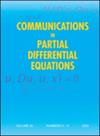Lotka-Volterra竞争扩散系统:关键竞争案例
IF 1.7
2区 数学
Q1 MATHEMATICS
Communications in Partial Differential Equations
Pub Date : 2021-09-30
DOI:10.1080/03605302.2023.2169936
引用次数: 1
摘要
摘要我们在所谓的临界竞争情况下考虑反应扩散竞争系统。相关的ODE系统允许无限多的平衡,这使得分析变得复杂。我们首先应用相平面分析证明了最终单调行波的不存在性。接下来,我们研究了具有紧支撑初始数据的柯西问题解的大时间行为。我们不仅揭示了“更快”的物种排除了“更慢”的物种(具有已知的扩散速度),而且对溶液的轮廓进行了清晰的描述,从而揭示了一种新的凸起现象。本文章由计算机程序翻译,如有差异,请以英文原文为准。
Lotka–Volterra competition-diffusion system: the critical competition case
Abstract We consider the reaction-diffusion competition system in the so-called critical competition case. The associated ODE system then admits infinitely many equilibria, which makes the analysis intricate. We first prove the nonexistence of ultimately monotone traveling waves by applying the phase plane analysis. Next, we study the large time behavior of the solution of the Cauchy problem with a compactly supported initial datum. We not only reveal that the “faster” species excludes the “slower” one (with a known spreading speed), but also provide a sharp description of the profile of the solution, thus shedding light on a new bump phenomenon.
求助全文
通过发布文献求助,成功后即可免费获取论文全文。
去求助
来源期刊
CiteScore
3.60
自引率
0.00%
发文量
43
审稿时长
6-12 weeks
期刊介绍:
This journal aims to publish high quality papers concerning any theoretical aspect of partial differential equations, as well as its applications to other areas of mathematics. Suitability of any paper is at the discretion of the editors. We seek to present the most significant advances in this central field to a wide readership which includes researchers and graduate students in mathematics and the more mathematical aspects of physics and engineering.

 求助内容:
求助内容: 应助结果提醒方式:
应助结果提醒方式:


